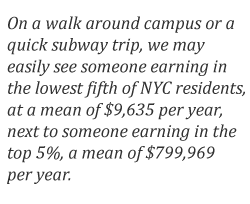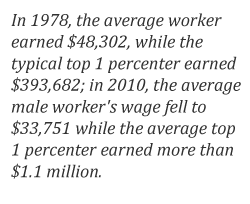Inequality for All @ PaceU
 In lower Manhattan, we are often exposed to the extremes of the income inequality in the United States. On a walk around campus or a quick subway trip, we may easily see someone earning in the lowest fifth of NYC residents, at a mean of $9,635 per year, next to someone earning in the top 5%, a mean of $799,969 per year (NY Times). For members of the Pace community, the question is not whether or not income inequality exists in the United States or even in Manhattan, but what income inequality means for the people and families living in one of the most unequal county in the country.
In lower Manhattan, we are often exposed to the extremes of the income inequality in the United States. On a walk around campus or a quick subway trip, we may easily see someone earning in the lowest fifth of NYC residents, at a mean of $9,635 per year, next to someone earning in the top 5%, a mean of $799,969 per year (NY Times). For members of the Pace community, the question is not whether or not income inequality exists in the United States or even in Manhattan, but what income inequality means for the people and families living in one of the most unequal county in the country.
Last night’s screening of Inequality for All, co-sponsored by the CCAR and Dyson Body & Mind House, attempted to answer that question by focusing on the struggle of today’s middle-class. Through the personal stories of families with $25 in their checking accounts, being laid off as companies like Circuit City go out of business, and wondering how to create wealth as they try to budget their incomes to stretch over rent, food, gas, and child care with only a few dollars to spare, former Secretary of Labor Robert Reich creates a contrast with figures like Nick Hanauer, the CEO of a pillow company who earns “between 10 and 30 million dollars per year; basically, a ridiculous amount of money” (in his own words). Hanauer is one of the first to point out a central tenant of the documentary’s argument, that the the first step to revitalizing the American economy is to empower the middle class and increase spending – after all, as Hanauer says, even millionaires “only buy so many pillows.”
 The people Reich speaks to are persuasive, but he backs up his argument with statistics, examinations of historic trends, and, possibly most importantly, an analysis of why the economy has fallen into the current recession. For example, Reich demonstrates the growing gap through the change in earnings of a “typical male worker” in 1978 to 2010 – in 1978, the average worker earned $48,302, while the typical top 1 percenter earned $393,682; in 2010, the average male worker’s wage fell to $33,751 while the average top 1 percenter earned more than $1.1 million. He speaks to unionized workers, politicians approached and influenced by wealthy lobbyists, and talks about why the income gap doesn’t just hurt the poor and middle-class, but everyone who lives and works in such an unequal economy: inequality for all.
The people Reich speaks to are persuasive, but he backs up his argument with statistics, examinations of historic trends, and, possibly most importantly, an analysis of why the economy has fallen into the current recession. For example, Reich demonstrates the growing gap through the change in earnings of a “typical male worker” in 1978 to 2010 – in 1978, the average worker earned $48,302, while the typical top 1 percenter earned $393,682; in 2010, the average male worker’s wage fell to $33,751 while the average top 1 percenter earned more than $1.1 million. He speaks to unionized workers, politicians approached and influenced by wealthy lobbyists, and talks about why the income gap doesn’t just hurt the poor and middle-class, but everyone who lives and works in such an unequal economy: inequality for all.
Pace students who participated in the follow-up discussion shared their feelings of fear about graduating into an economy in which they may struggle like the families shown in the film, paying back student debt that to the millionaires in the film amount to comparatively little money, and conflicting thoughts on Reich’s proposed solutions to this systemic issue. But the film ends on a note of hope, with a call from Reich to the students in his course at UC Berkeley, and college students across the country, to believe in their power to change the current system into one that is more fair and prosperous for all.
If you missed last night’s screening, Inequality for All is available on Netflix and DVD. If you were able to see the film, we’d love to hear your thoughts in the comments or on our Facebook page! Keep following us here (& check out our earlier post on the events happening this month), on Facebook, and on Twitter for more on inequality and what you can do to create change.





